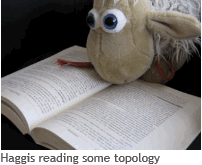|
|
|
|
|
|
|
News & Views item - July 2011 |
![]() Peter Rowlett on the Unplanned Impact of Mathematics. (July 14, 2011)
Peter Rowlett on the Unplanned Impact of Mathematics. (July 14, 2011)
Peter Rowlett has worked in maths and stats education since graduating from his first degree in 2002. In the July 14 issue of Nature he writes:
There has been pressure in recent years for researchers to predict the impact of their work before it is undertaken. Alan Thorpe, then chair of Research Councils UK, was quoted by Times Higher Education (22 October 2009) as saying: “We have to demonstrate to the taxpayer that this is an investment, and we do want researchers to think about what the impact of their work will be.” The US National Science Foundation is similarly focused on broader impacts of research proposals (see Nature 465, 416–418; 2010). However, predicting impact is extremely problematic. The latest International Review of Mathematical Sciences (Engineering and Physical Sciences Research Council; 2010), an independent assessment of the quality and impact of UK research, warned that even the most theoretical mathematical ideas “can be useful or enlightening in unexpected ways, sometimes several decades after their appearance”... There is no way to guarantee in advance what pure mathematics will later find application.
He then cites "seven little-known tales illustrating that theoretical work may
lead to practical applications, but it can't be forced". Here we reprint just
one of them supplied by
Julia Collins of the University of Edinburgh who attempts with the help
of her sheep Haggis to demonstrate the "beauty and amazingness" of maths:
Collins of the University of Edinburgh who attempts with the help
of her sheep Haggis to demonstrate the "beauty and amazingness" of maths:
When Leonhard Euler proved to the people of Königsberg in 1735 that they
could not traverse all of their seven bridges in one trip, he invented a new
kind of mathematics: one in which distances didn't matter. His solution relied
only on knowing the relative arrangements of the bridges, not on how long they
were or how big the land masses were. In 1847, Johann Benedict Listing finally
coined the term 'topology' to describe this new field, and for the next 150
years or so, mathematicians worked to understand the implications of its axioms.
For most of that time, topology was pursued as an intellectual challenge, with
no expectation of it being useful. After all, in real life, shape and
measurement are important: a doughnut is not the same as a coffee cup. Who would
ever care about 5-dimensional holes in abstract 11-dimensional spaces, or
whether surfaces had one or two sides? Even practical-sounding parts of topology
such as knot theory, which had its origins in attempts to understand the
structure of atoms, were thought to be useless for most of the nineteenth and
twentieth centuries.
Suddenly, in the 1990s, applications of topology started to appear. Slowly at
first, but gaining momentum until now it seems as if there are few areas in
which topology is not used. Biologists learn knot theory to understand DNA.
Computer scientists are using braids — intertwined strands of material running
in the same direction — to build quantum computers, while colleagues down the
corridor use the same theory to get robots moving. Engineers use one-sided
Möbius strips to make more efficient conveyer belts. Doctors depend on homology
theory to do brain scans, and cosmologists use it to understand how galaxies
form. Mobile-phone companies use topology to identify the holes in network
coverage; the phones themselves use topology to analyse the photos they take.
It is precisely because topology is free of distance measurements that it is so
powerful. The same theorems apply to any knotted DNA, regardless of how long it
is or what animal it comes from. We don't need different brain scanners for
people with different-sized brains. When Global Positioning System data about
mobile phones are unreliable, topology can still guarantee that those phones
will receive a signal. Quantum computing won't work unless we can build a robust
system impervious to noise, so braids are perfect for storing information
because they don't change if you wiggle them. Where will topology turn up next?